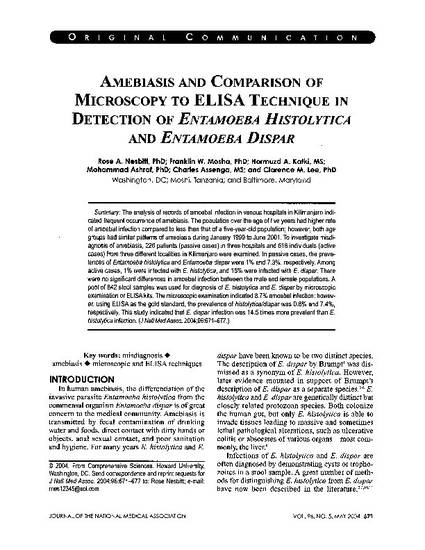
Article
Amebiasis and comparison of microscopy to ELISA technique in detection of Entamoeba histolytica and Entamoeba dispar
Journal of the National Medical Association
(2004)
Abstract
The analysis of records of amoebal infection in various hospitals in Kilimanjaro indicated frequent occurrence of amebiasis. The population over the age of five years had higher rate of amoebal infection compared to less than that of a five-year-old population; however, both age groups had similar patterns of amebiasis during January 1999 to June 2001. To investigate misdiagnosis of amebiasis, 226 patients (passive cases) in three hospitals and 616 individuals (active cases) from three different localities in Kilimanjaro were examined. In passive cases, the prevalences of Entamoeba histolytica and Entamoeba dispar were 1% and 7.3%, respectively. Among active cases, 1% were infected with E. histolytica, and 15% were infected with E. dispar. There were no significant differences in amoebal infection between the male and female populations. A pool of 842 stool samples was used for diagnosis of E. histolytica and E. dispar by microscopic examination or ELISA kits. The microscopic examination indicated 8.7% amoebal infection; however, using ELISA as the gold standard, the prevalence of histolytica/dispar was 0.8% and 7.4%, respectively. This study indicated that E. dispar infection was 14.5 times more prevalent than E. histolytica infection.
Disciplines
Publication Date
May, 2004
Citation Information
Clarence Lee. "Amebiasis and comparison of microscopy to ELISA technique in detection of Entamoeba histolytica and Entamoeba dispar" Journal of the National Medical Association Vol. 96 Iss. 5 (2004) p. 671 - 677 Available at: http://works.bepress.com/clarence-lee/1/
